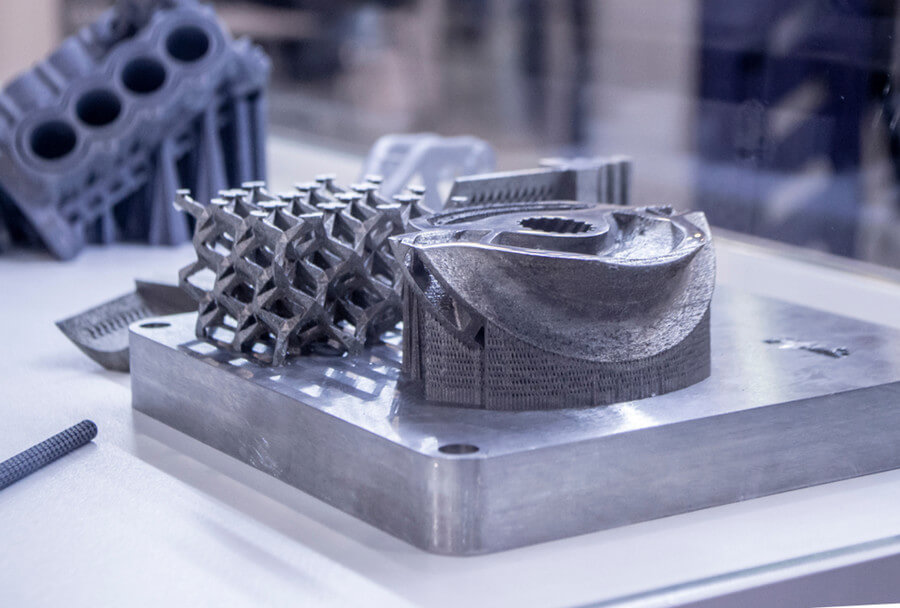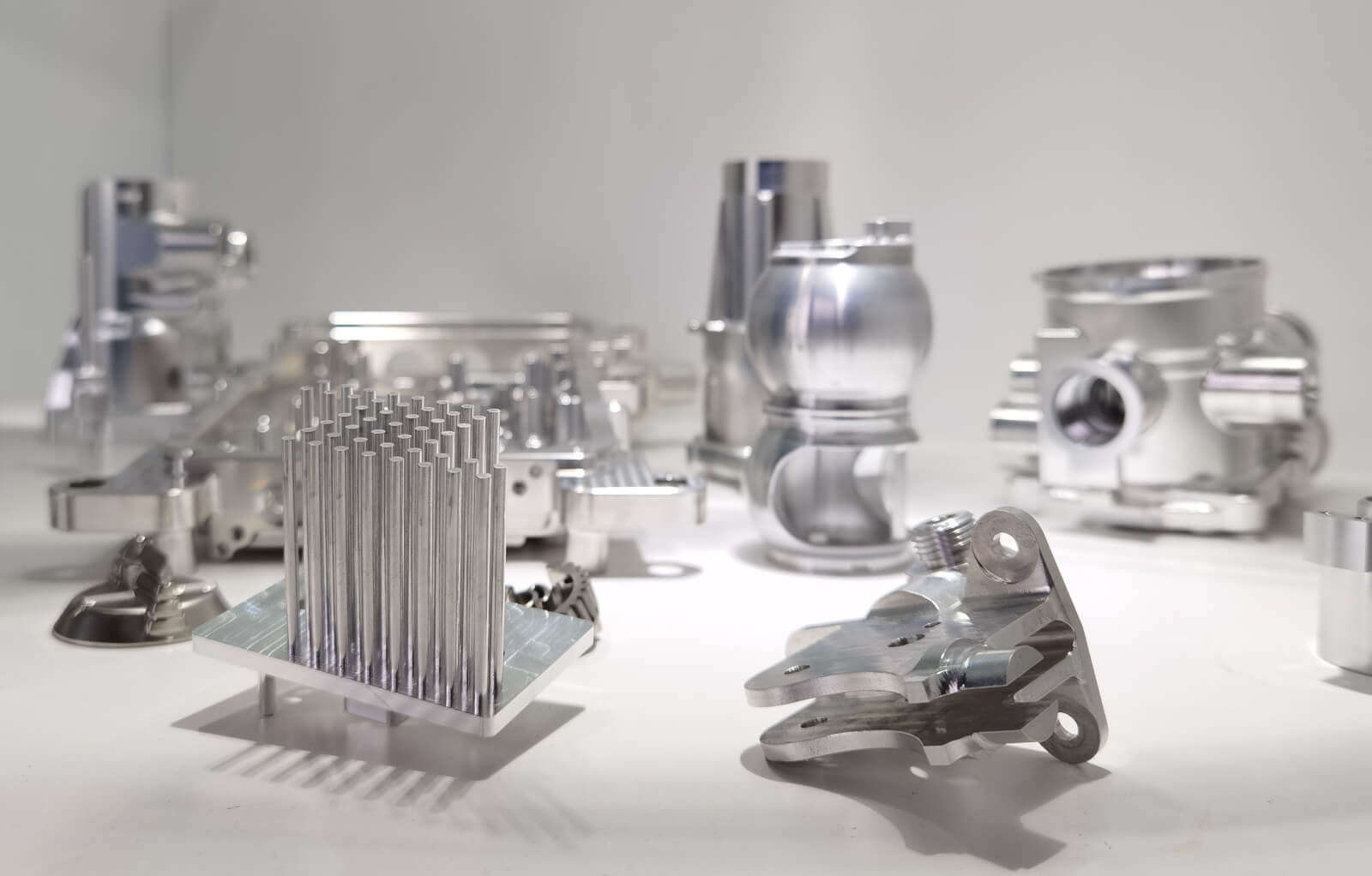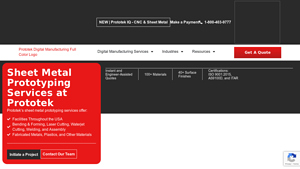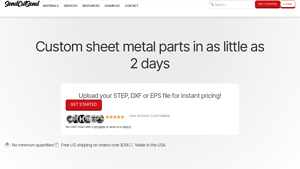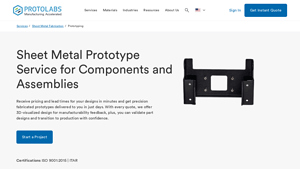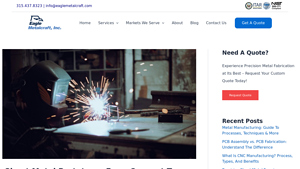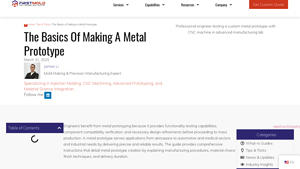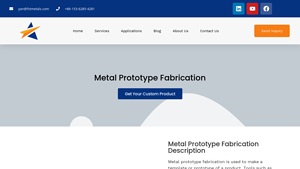Metal Prototype Fabrication Guide: Type, Cost, Top List…
Introduction: Navigating the Global Market for metal prototype fabrication
Navigating the complexities of sourcing metal prototype fabrication can be a daunting task for international B2B buyers, especially when aiming to innovate and bring products to market efficiently. In an increasingly competitive landscape, understanding the nuances of various fabrication techniques, materials, and supplier capabilities is crucial for success. This guide serves as a comprehensive resource, exploring the different types of metal prototype fabrication, their diverse applications across industries, and the critical factors to consider when vetting suppliers.
For buyers from Africa, South America, the Middle East, and Europe—regions characterized by unique market dynamics—this guide offers actionable insights to facilitate informed purchasing decisions. By delving into essential elements such as cost structures, turnaround times, and quality assurance measures, businesses can mitigate risks associated with sourcing and enhance their product development processes. Whether you are focused on automotive components, aerospace parts, or specialized industrial applications, understanding the global market for metal prototype fabrication empowers you to make strategic choices that align with your organizational goals.
Armed with this knowledge, you can confidently navigate the complexities of metal prototype fabrication, ensuring that your projects are not only feasible but also positioned for success in today’s fast-paced market.
Understanding metal prototype fabrication Types and Variations
| Type Name | Key Distinguishing Features | Primary B2B Applications | Brief Pros & Cons for Buyers |
|---|---|---|---|
| Sheet Metal Prototyping | Utilizes various cutting and forming techniques, such as laser and water jet cutting. | Automotive, Aerospace, Electronics | Pros: Cost-effective, fast turnaround, functional testing. Cons: Limited to flat or slightly curved designs. |
| Additive Manufacturing | Builds prototypes layer by layer, often using metals like titanium or aluminum. | Aerospace, Medical Devices | Pros: Complex geometries, lightweight designs. Cons: Slower production speed, higher material costs. |
| CNC Machining | Employs computer-controlled machines for precision cutting and shaping. | Industrial Equipment, Defense | Pros: High precision, suitable for complex parts. Cons: Longer lead times, higher initial setup costs. |
| Casting | Involves pouring molten metal into a mold to create parts. | Automotive, Consumer Goods | Pros: Excellent for high-volume production, intricate shapes. Cons: Longer lead times, potential for defects. |
| Forging | Shapes metal using compressive forces, resulting in stronger parts. | Aerospace, Oil & Gas | Pros: Stronger material properties, suitable for high-stress applications. Cons: Limited design flexibility, higher costs. |
What are the Characteristics of Sheet Metal Prototyping?
Sheet metal prototyping is distinguished by its versatility in cutting and forming techniques, including laser and water jet cutting. It is particularly suitable for industries like automotive and aerospace, where rapid iteration is crucial. Buyers should consider the ability to validate designs quickly and cost-effectively, as well as the functionality of the prototypes, which can be tested before full-scale production.
How Does Additive Manufacturing Stand Out?
Additive manufacturing, also known as 3D metal printing, creates parts layer by layer, allowing for complex geometries that traditional methods cannot achieve. This method is especially relevant in aerospace and medical device sectors, where lightweight and intricate designs are required. However, buyers must be aware of the slower production speeds and higher costs associated with materials compared to other fabrication techniques.
What Advantages Does CNC Machining Offer?
CNC machining is characterized by its precision and ability to create complex shapes from various metals. It is widely used in the industrial equipment and defense sectors. Buyers value this method for its high accuracy and repeatability, although they should consider the longer lead times and higher initial setup costs that may be involved in CNC projects.
Why Choose Casting for Metal Prototyping?
Casting is a traditional method that involves pouring molten metal into molds to create parts. It is ideal for high-volume production, particularly in automotive and consumer goods industries. While casting allows for intricate shapes and large quantities, buyers should be mindful of the longer lead times and potential for defects that can arise during the casting process.
What are the Key Benefits of Forging?
Forging shapes metal using compressive forces, resulting in parts with superior strength and durability. This method is commonly used in the aerospace and oil & gas industries, where high-stress applications are prevalent. Buyers appreciate the enhanced material properties but should also consider the limited design flexibility and potentially higher costs associated with forging processes.
Key Industrial Applications of metal prototype fabrication
| Industry/Sector | Specific Application of Metal Prototype Fabrication | Value/Benefit for the Business | Key Sourcing Considerations for this Application |
|---|---|---|---|
| Automotive | Development of complex brackets and trim components | Accelerates design iterations and reduces costs | Supplier’s experience in automotive standards and certifications |
| Aerospace | Creation of lightweight structural components | Enhances performance while meeting strict regulations | Compliance with aerospace safety standards and material certifications |
| Electronics | Prototyping of enclosures and circuit boards | Ensures tight tolerances and high-quality finishes | Availability of advanced machining technologies and rapid turnaround times |
| Defense | Manufacturing of precision parts for military equipment | Meets high precision and durability requirements | ITAR compliance and experience in defense contracts |
| Life Sciences | Fabrication of components for medical devices | Ensures adherence to stringent quality and safety standards | Expertise in cleanroom manufacturing and regulatory knowledge |
How is Metal Prototype Fabrication Used in the Automotive Industry?
In the automotive sector, metal prototype fabrication is crucial for developing complex brackets and interior trim components. Rapid prototyping allows manufacturers to iterate designs quickly, reducing lead times and costs associated with traditional tooling methods. International buyers from regions like Europe and the Middle East must ensure that their suppliers adhere to automotive industry standards such as IATF 16949 to maintain quality and reliability in their products.
What Role Does Metal Prototype Fabrication Play in Aerospace Applications?
Aerospace companies leverage metal prototype fabrication to create lightweight structural components that are essential for enhancing aircraft performance. The industry demands high precision and compliance with strict regulations, necessitating suppliers with expertise in aerospace certifications. Buyers, particularly from Africa and South America, should prioritize sourcing partners with a proven track record in aerospace manufacturing to ensure their prototypes meet safety and performance standards.
How is Metal Prototype Fabrication Beneficial for the Electronics Sector?
In the electronics industry, metal prototype fabrication is utilized for creating enclosures and circuit boards that require tight tolerances and high surface quality. The ability to produce functional prototypes quickly allows companies to test designs before full-scale production. International buyers should consider suppliers that offer advanced machining technologies and rapid turnaround times to keep pace with the fast-evolving electronics market.
Why is Metal Prototype Fabrication Essential for Defense Manufacturing?
The defense sector relies on metal prototype fabrication for the production of precision parts used in military equipment. These prototypes must meet high standards of precision and durability, which are critical for operational effectiveness. Buyers in this sector, especially from regions like the Middle East, should focus on sourcing from ITAR-compliant manufacturers with experience in defense contracts to ensure that their products meet necessary regulations and performance expectations.
How Does Metal Prototype Fabrication Support Life Sciences Innovations?
In the life sciences field, metal prototype fabrication is essential for the production of components used in medical devices. The industry mandates strict adherence to quality and safety standards, making it imperative for manufacturers to have experience in cleanroom environments and regulatory compliance. International buyers should seek suppliers who demonstrate expertise in both the technical requirements and regulatory landscapes relevant to medical device manufacturing to ensure the reliability and safety of their products.
3 Common User Pain Points for ‘metal prototype fabrication’ & Their Solutions
Scenario 1: Long Lead Times Causing Project Delays
The Problem: In the fast-paced world of product development, B2B buyers often face the significant challenge of long lead times when sourcing metal prototypes. Delays can stem from several factors, including limited fabrication capabilities, high demand for specific materials, or inefficient supply chains. Such delays not only hinder product launches but can also lead to lost market opportunities and increased costs due to extended project timelines. Buyers may find themselves in a tight spot, needing prototypes urgently to meet deadlines for client presentations or regulatory submissions.
The Solution: To combat long lead times, buyers should look for manufacturers that specialize in rapid prototyping and have robust supply chain management systems in place. One effective strategy is to partner with companies that utilize advanced technologies, such as laser cutting or water jet cutting, which can significantly reduce production time. Additionally, setting up clear communication channels with manufacturers can help buyers understand the production timeline and identify any potential bottlenecks early on. Utilizing online platforms that offer instant pricing and quick turnaround options can also expedite the ordering process. By establishing relationships with multiple suppliers, buyers can ensure they have alternatives ready if a particular vendor cannot meet their timeline.
Scenario 2: Difficulty in Achieving Precision in Complex Designs
The Problem: Many B2B buyers encounter challenges when it comes to fabricating metal prototypes with intricate designs. Complex geometries require high precision, and any discrepancies can lead to functional issues in the final product. This is particularly critical in industries such as aerospace or medical devices, where tolerances are strict, and even minor errors can have serious implications. The struggle to find a fabrication partner capable of delivering the required precision can be frustrating and costly.
The Solution: Buyers should prioritize manufacturers that utilize specialized equipment and techniques for high-precision metal fabrication. For example, technologies such as micro water jet cutting and wire EDM (Electrical Discharge Machining) can achieve tolerances as tight as 0.0005 inches, ensuring that even the most complex designs are executed flawlessly. When engaging with potential suppliers, buyers should request samples of previous work to assess the quality and precision of their output. Collaborating closely with engineering teams during the design phase can also facilitate the use of design-for-manufacturing principles, optimizing designs for easier fabrication without compromising on quality.
Scenario 3: Limited Material Options Leading to Design Constraints
The Problem: B2B buyers often find themselves constrained by the limited material options available for metal prototype fabrication. This limitation can stifle innovation and prevent the exploration of new design possibilities, particularly in industries that require specific material properties such as strength, corrosion resistance, or weight considerations. Moreover, if a supplier does not stock a necessary material, the buyer faces delays and additional costs to source it elsewhere.
The Solution: To mitigate material constraints, buyers should seek fabrication partners that offer a diverse range of materials and thicknesses. Working with suppliers that stock over 170 materials, including various grades of aluminum, stainless steel, and specialized alloys, can provide the flexibility needed to experiment with different designs. It is also beneficial to engage in discussions with manufacturers about material performance characteristics and how they align with project requirements. Buyers can consider using online platforms that allow them to visualize different materials and their properties, making it easier to choose the most suitable option for their prototypes. Additionally, leveraging the expertise of the supplier’s engineering team can help identify optimal material choices early in the design process, preventing costly design revisions later on.
Strategic Material Selection Guide for metal prototype fabrication
What Are the Key Properties of Aluminum in Metal Prototype Fabrication?
Aluminum is a popular choice for metal prototype fabrication due to its lightweight nature and excellent corrosion resistance. It typically has a temperature rating of up to 150°C (302°F) and can withstand moderate pressure, making it suitable for various applications. Aluminum alloys, such as 6061 and 7075, offer enhanced strength and machinability, making them ideal for intricate designs.
Pros and Cons: The primary advantage of aluminum is its low density, which reduces shipping costs and makes it easier to handle. However, its lower strength compared to steel can be a limitation for heavy-duty applications. Additionally, while aluminum is generally cost-effective, high-grade alloys can be more expensive, impacting budget constraints for some projects.
Impact on Application: Aluminum is compatible with a variety of media, including water and air, but may not be suitable for high-temperature applications involving aggressive chemicals. International buyers should consider the specific alloy’s properties to ensure it meets their operational requirements.
Considerations for International Buyers: Buyers from regions like Europe and the Middle East should be aware of compliance with standards such as ASTM and EN. In countries like Germany, there is a strong emphasis on quality certifications, which can affect sourcing decisions.
How Does Stainless Steel Compare for Metal Prototype Fabrication?
Stainless steel is renowned for its exceptional durability and resistance to corrosion and oxidation. It typically performs well in high-pressure and high-temperature environments, with temperature ratings reaching up to 800°C (1472°F) depending on the specific grade. This makes it an excellent choice for industries such as automotive and aerospace.
Pros and Cons: The key advantage of stainless steel is its strength and longevity, making it suitable for demanding applications. However, it is generally more expensive than aluminum and can be more challenging to machine, leading to higher manufacturing costs.
Impact on Application: Stainless steel is compatible with a wide range of media, including chemicals and food products, making it ideal for applications in the life sciences and food industries.
Considerations for International Buyers: Buyers should ensure compliance with international standards such as ASTM A240 for stainless steel grades. In regions like South America, understanding local regulations regarding food-grade materials is crucial for compliance.
What Are the Benefits of Carbon Steel in Metal Prototype Fabrication?
Carbon steel is a versatile material commonly used in metal prototype fabrication. It offers good strength and hardness, with temperature ratings typically around 300°C (572°F). Its corrosion resistance is lower than that of stainless steel, but it can be enhanced through coatings.
Pros and Cons: Carbon steel is relatively inexpensive and easy to machine, making it a cost-effective option for many projects. However, its susceptibility to rust and corrosion can be a significant drawback, especially in harsh environments.
Impact on Application: Carbon steel is suitable for structural components and parts that do not require high corrosion resistance. It is often used in the automotive and construction industries, where strength is prioritized over weight.
Considerations for International Buyers: Buyers should be aware of the need for protective coatings in humid environments. Compliance with standards such as ASTM A36 is essential, particularly in regions like Africa, where local sourcing may require adherence to specific regulations.
How Does Copper Fit into the Metal Prototype Fabrication Landscape?
Copper is less common but still valuable in metal prototype fabrication, especially for electrical applications. It has excellent thermal and electrical conductivity, making it ideal for components such as connectors and circuit boards. Its temperature rating can reach up to 200°C (392°F).
Pros and Cons: The primary advantage of copper is its superior conductivity, which is critical in electrical applications. However, it is relatively soft and can be prone to deformation under stress, limiting its use in structural applications. Additionally, copper is generally more expensive than aluminum and carbon steel.
Impact on Application: Copper is highly compatible with electrical media, making it essential in the electronics industry. However, its corrosion resistance is limited, necessitating protective coatings in certain environments.
Considerations for International Buyers: Buyers should ensure compliance with standards such as ASTM B152 for copper alloys. In Europe, there may be additional regulations regarding the use of copper in electrical components, making it essential to verify local compliance.
Summary Table of Material Selection for Metal Prototype Fabrication
| Material | Typical Use Case for metal prototype fabrication | Key Advantage | Key Disadvantage/Limitation | Relative Cost (Low/Med/High) |
|---|---|---|---|---|
| Aluminum | Aerospace components, automotive parts | Lightweight and corrosion-resistant | Lower strength compared to steel | Medium |
| Stainless Steel | Food processing equipment, automotive parts | High strength and corrosion resistance | Higher cost and machining complexity | High |
| Carbon Steel | Structural components, automotive applications | Cost-effective and easy to machine | Susceptible to rust and corrosion | Low |
| Copper | Electrical connectors, circuit boards | Excellent electrical conductivity | Soft and prone to deformation | High |
In-depth Look: Manufacturing Processes and Quality Assurance for metal prototype fabrication
What Are the Main Stages of Metal Prototype Fabrication?
Metal prototype fabrication involves a series of critical stages, each contributing to the final quality and functionality of the product. Understanding these stages helps B2B buyers make informed decisions when selecting a supplier.
1. Material Preparation
The first step in the fabrication process is material preparation. This involves selecting the appropriate metal based on the application requirements, such as strength, weight, and corrosion resistance. Common materials used in metal prototyping include aluminum, stainless steel, and carbon steel.
Once the material is selected, it undergoes processes like cutting, shearing, or punching to achieve the desired dimensions. Advanced techniques like laser cutting or water jet cutting are often employed due to their precision and ability to minimize waste. This stage sets the foundation for the entire fabrication process, ensuring that the material meets the required specifications.
2. Forming Techniques
After material preparation, the next phase is forming, where the raw material is shaped into the desired configuration. Key techniques include:
- Bending: This process uses press brakes to create angles and curves in the metal, allowing for complex shapes.
- Stamping: Utilizing dies, this method is effective for producing large quantities of identical parts with precision.
- Welding: This is crucial for assembling various components, ensuring structural integrity and strength.
- Machining: CNC machining may be employed for high-precision requirements, particularly for intricate designs.
The choice of forming technique often depends on the complexity of the design and the material properties.
3. Assembly
In the assembly stage, components produced in previous steps are brought together to form the final prototype. This can involve mechanical fastening, welding, or adhesive bonding. Precision is essential during this stage to maintain the quality and functionality of the prototype.
B2B buyers should inquire about the assembly techniques used by their suppliers, as these can significantly affect the durability and performance of the final product.
4. Finishing Processes
Finishing processes enhance the aesthetic and functional qualities of the metal prototype. Techniques such as powder coating, anodizing, or plating can be applied to improve corrosion resistance, surface finish, and overall appearance.
Finishing not only impacts the prototype’s longevity but also its compliance with industry standards, making it a crucial step in the fabrication process.
How Is Quality Assurance Implemented in Metal Prototype Fabrication?
Quality assurance (QA) is vital in ensuring that metal prototypes meet the required specifications and standards. A robust QA process involves multiple checkpoints and testing methods throughout the fabrication stages.
Relevant International Standards for Quality Assurance
B2B buyers should ensure their suppliers adhere to relevant international standards. ISO 9001 is a widely recognized quality management standard applicable across various industries. This certification indicates that a supplier has established a quality management system focused on continuous improvement and customer satisfaction.
Additionally, industry-specific certifications like CE for European markets or API for the oil and gas sector may be crucial, depending on the application of the metal prototypes.
What Are the Key Quality Control Checkpoints?
Quality control (QC) checkpoints are integral to the QA process, allowing for the identification and rectification of defects before the product reaches the customer. Typical QC checkpoints include:
- Incoming Quality Control (IQC): This initial checkpoint assesses the quality of raw materials upon receipt, ensuring they meet specified standards.
- In-Process Quality Control (IPQC): Conducted during the fabrication process, IPQC involves monitoring and testing at various stages to ensure compliance with design specifications.
- Final Quality Control (FQC): This final checkpoint occurs before shipment, where the completed prototype undergoes comprehensive testing and inspection.
By implementing these checkpoints, suppliers can maintain high-quality standards and minimize the risk of defects.
Common Testing Methods Used in Quality Assurance
Various testing methods are employed to verify the quality of metal prototypes, including:
- Visual Inspection: A straightforward method to identify surface defects or inconsistencies.
- Dimensional Inspection: Using tools like calipers and gauges to ensure that the prototype meets the specified dimensions.
- Non-Destructive Testing (NDT): Techniques such as ultrasonic testing or X-ray inspection are used to assess material integrity without causing damage.
- Functional Testing: Ensuring that the prototype performs as intended under operational conditions.
B2B buyers should ask their suppliers about the specific testing methods they employ and the frequency of these tests.
How Can B2B Buyers Verify Supplier Quality Control?
To ensure that a supplier meets high-quality standards, B2B buyers can take several steps to verify their QC processes:
-
Supplier Audits: Conducting audits provides an in-depth understanding of a supplier’s manufacturing processes and quality control measures. This can reveal their commitment to maintaining standards.
-
Requesting QC Reports: Suppliers should provide documented evidence of their QC processes, including inspection reports and testing results. This transparency is crucial for building trust.
-
Third-Party Inspections: Engaging third-party inspection services can offer an unbiased assessment of a supplier’s quality management practices. This is particularly beneficial for international buyers unfamiliar with local suppliers.
What Are the Quality Control Nuances for International B2B Buyers?
International B2B buyers must consider additional nuances related to quality control when sourcing metal prototypes:
-
Regulatory Compliance: Different countries have varying regulations regarding product safety and quality. Buyers must ensure their suppliers comply with local laws and international standards.
-
Cultural Differences: Quality perceptions may vary across regions. Understanding these differences can help buyers set realistic expectations regarding quality levels and communication.
-
Logistics and Supply Chain Considerations: International shipping can introduce risks to product quality. Buyers should discuss packaging and handling procedures with suppliers to mitigate these risks.
By being diligent about these aspects, B2B buyers can enhance their procurement processes and secure high-quality metal prototypes that meet their specific needs.
Practical Sourcing Guide: A Step-by-Step Checklist for ‘metal prototype fabrication’
Introduction
This practical sourcing guide serves as a comprehensive checklist for B2B buyers looking to procure metal prototype fabrication services. By following these steps, you can streamline your sourcing process, ensure quality, and mitigate risks while selecting a capable supplier for your metal prototyping needs.
Step 1: Define Your Technical Specifications
Establishing clear technical specifications is the foundation of a successful metal prototype fabrication project. Detail the dimensions, tolerances, materials, and any specific features required for your prototypes. This clarity will not only guide potential suppliers in providing accurate quotes but also help in assessing their capabilities to meet your needs.
- Considerations:
- Specify the type of metal required (e.g., aluminum, stainless steel, etc.).
- Include any secondary processes like coating or finishing.
Step 2: Research and Identify Potential Suppliers
Conduct thorough research to compile a list of potential suppliers who specialize in metal prototype fabrication. Look for companies with experience in your industry and those that have a strong reputation for quality and reliability.
- Sources for Research:
- Industry directories and trade shows.
- Online platforms and forums where professionals discuss supplier experiences.
Step 3: Evaluate Supplier Capabilities
Before committing to a supplier, assess their capabilities to ensure they align with your project requirements. This includes reviewing their machinery, technology, and production processes to confirm they can handle your specifications.
- Key Aspects to Review:
- Types of fabrication techniques offered (e.g., laser cutting, water jet cutting).
- Capacity for quick turnaround times, especially if you require rapid prototyping.
Step 4: Request Quotes and Compare Pricing
Once you have shortlisted potential suppliers, request detailed quotes from each. Ensure that the quotes are itemized, showing costs for materials, labor, and any additional services.
- What to Look For:
- Comparison of unit prices based on different quantities.
- Transparency in pricing to avoid hidden costs later in the project.
Step 5: Check Certifications and Compliance
Verify that the suppliers have the necessary certifications and compliance with industry standards. This step is crucial for ensuring quality and safety, especially in regulated industries like aerospace and medical.
- Important Certifications:
- ISO 9001 for quality management.
- Industry-specific certifications relevant to your sector.
Step 6: Request Samples and Prototypes
Before finalizing your choice, ask for samples or prototypes to evaluate the supplier’s quality and craftsmanship. This step can help you identify any potential issues early on and ensure that their work meets your expectations.
- What to Assess:
- Quality of finish and precision of the prototype.
- Ability to meet specified tolerances and requirements.
Step 7: Establish Clear Communication and Terms
Once you have selected a supplier, set up clear communication channels and establish terms of service. Ensure that both parties understand project timelines, deliverables, and payment terms to avoid misunderstandings.
- Key Communication Points:
- Regular updates on project progress.
- Clear guidelines for revisions or changes to the project scope.
By following this checklist, B2B buyers can effectively navigate the complexities of sourcing metal prototype fabrication services, ensuring that they partner with a supplier capable of delivering high-quality results on time.
Comprehensive Cost and Pricing Analysis for metal prototype fabrication Sourcing
What Are the Key Cost Components in Metal Prototype Fabrication?
When sourcing metal prototype fabrication, understanding the cost structure is crucial for B2B buyers. The main cost components include:
-
Materials: The choice of material significantly influences the overall cost. Common materials such as aluminum, steel, and specialized alloys come with varying price points. For instance, aluminum is generally more expensive than steel, but its lightweight properties may justify the cost in applications requiring reduced weight.
-
Labor: Labor costs encompass the expertise required for both manual and automated processes. Skilled labor for tasks such as precision cutting and assembly often commands higher rates, particularly in regions with a strong emphasis on craftsmanship.
-
Manufacturing Overhead: This includes expenses related to facility maintenance, utilities, and equipment depreciation. Efficient manufacturing processes can help mitigate these costs, making it essential to partner with suppliers who optimize their operations.
-
Tooling: Initial tooling costs can be substantial, especially for custom designs. However, investing in quality tooling is crucial to ensure accuracy and reduce defects, which can lead to cost savings in the long run.
-
Quality Control (QC): Ensuring that prototypes meet specified tolerances and standards requires rigorous QC processes. While this can add to the initial expense, it is vital for preventing costly rework or product failures.
-
Logistics: Transportation costs vary based on the distance and mode of shipment. International buyers must consider customs duties, freight charges, and delivery timelines, which can significantly affect the total cost.
-
Margin: Suppliers typically include a margin that reflects their operational risks and desired profit. Understanding this aspect can aid in negotiations.
How Do Price Influencers Affect Metal Prototype Fabrication Costs?
Several factors can influence pricing in metal prototype fabrication:
-
Volume and Minimum Order Quantity (MOQ): Larger orders often lead to lower per-unit costs due to economies of scale. However, some suppliers may offer competitive pricing even for small batches, catering to startups and smaller enterprises.
-
Specifications and Customization: Highly customized designs may incur additional costs due to complex tooling or specialized processes. Clear communication of requirements can help avoid unexpected expenses.
-
Materials and Quality Certifications: The choice of materials impacts both cost and quality. Materials with specific certifications (e.g., aerospace-grade) may come at a premium but are essential for certain applications.
-
Supplier Factors: The supplier’s location, reputation, and production capabilities can significantly influence pricing. Suppliers in regions with lower labor costs may offer more competitive rates.
-
Incoterms: Understanding shipping terms (e.g., FOB, CIF) is critical for assessing the total landed cost. Buyers must clarify responsibilities for logistics and customs duties to avoid unforeseen expenses.
What Are the Best Practices for Negotiating Metal Prototype Fabrication Costs?
When engaging with suppliers, international B2B buyers should consider the following tips:
-
Negotiate Volume Discounts: Leverage larger orders or long-term contracts to negotiate better rates. Suppliers are often willing to provide discounts for guaranteed business.
-
Evaluate Total Cost of Ownership (TCO): Look beyond initial pricing to consider the entire lifecycle cost of the prototype, including rework, shipping, and potential delays. A higher initial investment may lead to greater savings in the long run.
-
Understand Pricing Nuances for International Transactions: Different regions may have varying pricing structures due to labor and material costs. Familiarize yourself with local market conditions in Africa, South America, the Middle East, and Europe to make informed decisions.
-
Request Detailed Quotes: A comprehensive quote that breaks down costs into components (materials, labor, overhead, etc.) provides clarity and helps identify areas for negotiation.
-
Be Prepared for Currency Fluctuations: When dealing with international suppliers, currency volatility can impact costs. Consider locking in prices or using hedging strategies to mitigate risks.
Disclaimer on Pricing
The prices mentioned in this analysis are indicative and can vary significantly based on market conditions, supplier capabilities, and specific project requirements. Always consult with multiple suppliers for accurate quotes tailored to your needs.
Alternatives Analysis: Comparing metal prototype fabrication With Other Solutions
Exploring Alternatives to Metal Prototype Fabrication
In the realm of product development, businesses often seek various methods to create prototypes. Metal prototype fabrication is a popular choice due to its durability and functionality. However, alternative solutions can also provide valuable benefits depending on specific project requirements. This analysis compares metal prototype fabrication with two viable alternatives: 3D printing and injection molding.
Comparison Table
| Comparison Aspect | Metal Prototype Fabrication | 3D Printing | Injection Molding |
|---|---|---|---|
| Performance | High precision and durability for functional testing. | Good for complex geometries but may lack structural integrity. | Excellent for high-volume production with consistent quality. |
| Cost | Moderate initial costs, lower than machining. | Low setup costs, but material costs can add up. | High initial tooling costs, but cost-effective for large runs. |
| Ease of Implementation | Requires specialized equipment and expertise. | User-friendly software and processes, suitable for various skill levels. | Complex setup requires expertise and significant lead time. |
| Maintenance | Low maintenance for machinery; needs skilled operators. | Minimal maintenance; however, requires regular calibration. | High maintenance due to wear and tear on molds. |
| Best Use Case | Functional prototypes needing durability and testing. | Rapid prototyping for complex designs and iterations. | Mass production of parts with high precision requirements. |
In-Depth Analysis of Alternatives
What Are the Advantages and Disadvantages of 3D Printing?
3D printing, or additive manufacturing, is a versatile technique that allows for rapid prototyping of complex geometries. One of its primary advantages is the low cost of entry, as it does not require extensive tooling. This method is particularly effective for small batch runs and for designs that may need frequent adjustments. However, 3D printing typically produces parts that may not be as strong or durable as those created through metal prototype fabrication, limiting its use for functional testing in demanding environments.
How Does Injection Molding Compare to Metal Prototype Fabrication?
Injection molding excels in high-volume production and is known for its ability to create parts with high consistency and precision. While it is cost-effective when producing large quantities, the initial investment in tooling can be substantial, making it less ideal for low-volume projects or prototyping. Additionally, the lead time for creating molds can delay the prototyping phase. However, once set up, injection molding can deliver parts quickly and efficiently, making it a strong choice for businesses looking to scale production after prototyping.
Conclusion: Which Solution Should B2B Buyers Choose?
When selecting the right prototyping method, B2B buyers must consider their specific needs, including production volume, budget constraints, and the functional requirements of the prototype. Metal prototype fabrication is ideal for projects requiring high durability and functionality, particularly in industries such as automotive and aerospace. Conversely, if rapid iterations and complex designs are the priority, 3D printing may be the better choice. For businesses focusing on mass production with stringent quality control, injection molding can provide the best long-term value. Ultimately, understanding the strengths and limitations of each option will empower buyers to make informed decisions that align with their strategic goals.
Essential Technical Properties and Trade Terminology for metal prototype fabrication
What Are the Key Technical Properties in Metal Prototype Fabrication?
When engaging in metal prototype fabrication, understanding critical technical properties is essential for making informed purchasing decisions. Here are some key specifications that B2B buyers should consider:
Material Grade
Material grade refers to the specific classification of metal based on its composition and properties. Common grades include stainless steel (e.g., 304, 316), aluminum alloys (e.g., 6061, 7075), and carbon steel. The chosen material grade impacts the strength, corrosion resistance, and machinability of the final product. Selecting the right grade ensures the prototype meets functional requirements while minimizing long-term costs related to maintenance or replacements.
Tolerance
Tolerance defines the permissible limit of variation in a physical dimension. In metal fabrication, tighter tolerances (e.g., ±0.001 inches) can significantly impact the prototype’s performance, especially in applications where precision is critical, such as aerospace or medical devices. Understanding tolerance specifications helps buyers ensure their prototypes will fit seamlessly into existing systems, reducing the risk of costly rework or delays.
Surface Finish
Surface finish describes the texture and smoothness of a metal part’s surface. Common finishes include anodizing, powder coating, and plating. The right surface finish not only enhances aesthetics but also affects functionality, such as corrosion resistance and friction. B2B buyers should evaluate surface finish options based on their industry requirements to ensure optimal performance and durability.
Thickness
Thickness is a fundamental property of metal sheets and components that can influence strength and weight. Different applications may require varying thicknesses; for instance, automotive parts often demand lighter materials to improve fuel efficiency, while heavy machinery components may require thicker materials for added strength. Buyers should specify thickness requirements to ensure prototypes are fit for purpose.
Mechanical Properties
Mechanical properties, including tensile strength, yield strength, and ductility, provide insights into how a metal will perform under stress. These characteristics are crucial for applications in demanding industries such as construction or defense. B2B buyers should prioritize mechanical properties that align with their specific operational needs, ensuring that the fabricated parts will withstand the intended load and usage conditions.
What Are Common Trade Terms Used in Metal Prototype Fabrication?
Navigating the world of metal prototype fabrication requires familiarity with specific trade terminology. Here are some commonly used terms that every B2B buyer should understand:
OEM (Original Equipment Manufacturer)
An OEM refers to a company that produces parts or equipment that are then marketed by another company. In the context of metal fabrication, understanding OEM relationships can be crucial for buyers looking to source components that fit seamlessly into larger systems or assemblies.
MOQ (Minimum Order Quantity)
MOQ is the smallest quantity of a product that a supplier is willing to sell. This term is significant for buyers who may only need a few prototypes for testing. Knowing the MOQ helps in budgeting and assessing whether a supplier can meet specific project needs without incurring unnecessary costs.
RFQ (Request for Quotation)
An RFQ is a formal process where a buyer solicits price quotes from suppliers for specific products or services. It allows buyers to compare pricing, lead times, and capabilities among different vendors. For effective procurement, understanding how to craft a comprehensive RFQ can lead to better pricing and service agreements.
Incoterms
Incoterms (International Commercial Terms) are a set of predefined commercial terms widely used in international trade. They define the responsibilities of buyers and sellers regarding the delivery of goods. Familiarity with Incoterms is essential for B2B buyers to understand shipping costs, risks, and responsibilities when sourcing metal prototypes from international suppliers.
Lead Time
Lead time refers to the amount of time it takes from placing an order to receiving the finished product. In metal fabrication, shorter lead times can significantly influence project timelines and market competitiveness. Buyers should communicate their lead time requirements clearly to ensure timely delivery and avoid project delays.
Understanding these technical properties and trade terms is essential for B2B buyers in the metal prototype fabrication industry. By being informed, decision-makers can optimize their sourcing strategies, reduce costs, and enhance the overall quality of their products.
Navigating Market Dynamics and Sourcing Trends in the metal prototype fabrication Sector
What Are the Current Market Dynamics and Key Trends in Metal Prototype Fabrication?
The metal prototype fabrication sector is experiencing significant transformations driven by technological advancements and evolving market demands. Globally, the shift towards rapid prototyping is fueled by the need for faster product development cycles and cost efficiency. Companies are increasingly adopting digital manufacturing technologies, such as laser cutting and waterjet cutting, which allow for high precision and quick turnaround times. Notably, businesses in regions such as Africa, South America, the Middle East, and Europe, including Saudi Arabia and Germany, are leveraging these technologies to streamline their operations and enhance product quality.
Emerging trends include the rise of on-demand manufacturing platforms, which cater to B2B buyers seeking customized solutions without the burden of large minimum order quantities. This trend is particularly appealing in developing markets where flexibility and affordability are paramount. Furthermore, advancements in automation and AI are reshaping the procurement landscape, enabling companies to optimize their sourcing strategies and reduce lead times significantly. The integration of cloud-based design tools also facilitates collaboration across borders, allowing international buyers to work closely with manufacturers in real time.
How Is Sustainability and Ethical Sourcing Impacting Metal Prototype Fabrication?
Sustainability has become a critical concern in the metal prototype fabrication sector, influencing sourcing decisions for B2B buyers. The environmental impact of metal production—ranging from resource extraction to energy-intensive manufacturing processes—has prompted companies to seek greener alternatives. Ethical sourcing is now a priority, with businesses increasingly looking for suppliers that comply with environmental regulations and sustainability certifications.
Utilizing recycled materials and eco-friendly processes not only minimizes waste but also enhances brand reputation among environmentally conscious consumers. Certifications such as ISO 14001 (Environmental Management) and adherence to the EU’s Circular Economy Action Plan are becoming essential for suppliers looking to compete in the global market. Additionally, buyers are encouraged to engage with manufacturers who prioritize transparency in their supply chains, thereby ensuring that their sourcing decisions contribute positively to social and environmental outcomes.
What Is the Historical Context of Metal Prototype Fabrication?
The evolution of metal prototype fabrication can be traced back to the industrial revolution, where metalworking techniques began to advance significantly. Initially, processes were labor-intensive and time-consuming, limiting the ability to produce prototypes quickly. However, the introduction of CNC (Computer Numerical Control) machining in the late 20th century revolutionized the industry by enabling precise and automated fabrication.
In recent years, the advent of digital technologies, such as 3D printing and laser cutting, has further transformed the landscape, allowing for rapid iteration and the ability to produce complex geometries that were previously unattainable. This historical progression highlights the industry’s adaptability and responsiveness to changing market needs, setting the stage for the current emphasis on speed, precision, and sustainability in metal prototype fabrication.
In conclusion, understanding these dynamics and trends provides international B2B buyers with valuable insights into navigating the metal prototype fabrication sector effectively. By aligning their sourcing strategies with technological advancements and sustainability goals, companies can enhance their competitive edge in a rapidly evolving marketplace.
Frequently Asked Questions (FAQs) for B2B Buyers of metal prototype fabrication
-
How do I choose the right metal prototype fabrication supplier?
When selecting a metal prototype fabrication supplier, consider their experience, technological capabilities, and industry reputation. Look for suppliers that specialize in your specific application and have a robust portfolio showcasing past projects. Additionally, assess their quality assurance processes and certifications relevant to your industry, such as ISO standards. Engaging in initial consultations can also help gauge their responsiveness and willingness to collaborate. Finally, seek testimonials or references from past clients to ensure they meet your expectations for service and quality. -
What is the best material for metal prototypes?
The choice of material for metal prototypes largely depends on the intended application and desired characteristics. Common materials include aluminum for lightweight applications, steel for strength and durability, and stainless steel for corrosion resistance. If functionality testing is a priority, consider materials that closely mimic the final product’s specifications. Also, assess availability and cost-effectiveness, especially when sourcing from international suppliers. Consulting with your fabrication partner can provide insights into the best material options based on your specific needs. -
What are the typical lead times for metal prototype fabrication?
Lead times for metal prototype fabrication can vary significantly based on the complexity of the design, the chosen materials, and the supplier’s capabilities. Generally, you can expect a turnaround of anywhere from a few days to several weeks. For rapid prototyping, some suppliers offer expedited services that can reduce lead times to as little as 2-4 days. It’s essential to communicate your timeline needs upfront with potential suppliers to ensure they can meet your deadlines while maintaining quality. -
Are there minimum order quantities (MOQs) for metal prototypes?
Many metal prototype fabrication suppliers have flexible policies regarding minimum order quantities. Some offer no minimums, allowing you to order just one prototype, which is ideal for startups or projects in early development stages. However, others may require a minimum to justify production costs. Be sure to clarify MOQ policies with your suppliers early in the discussions to avoid any misunderstandings that could affect your project timeline or budget. -
What payment terms should I expect from metal fabrication suppliers?
Payment terms can vary widely among metal fabrication suppliers and often depend on the size of the order and the business relationship. Common terms include upfront payments, deposits, or payment upon delivery. For international transactions, be aware of currency exchange rates and additional fees. It’s advisable to discuss and agree upon payment terms before commencing production to ensure clarity and avoid potential disputes. -
How can I ensure quality assurance in metal prototype fabrication?
To ensure quality assurance in metal prototype fabrication, inquire about the supplier’s quality control processes and certifications. Look for suppliers that utilize advanced inspection techniques such as CNC metrology or non-destructive testing. Request documentation of their quality management systems, like ISO 9001 certifications, and ask for sample prototypes to evaluate their capabilities. Establish clear specifications and expectations upfront, and consider implementing a review process at various stages of production to monitor quality. -
What logistics considerations should I keep in mind when sourcing metal prototypes internationally?
When sourcing metal prototypes internationally, logistics considerations include shipping methods, customs regulations, and delivery timelines. Choose a supplier experienced in international shipping to navigate potential challenges. Understand the incoterms that define responsibilities for shipping costs and risks. Additionally, factor in potential tariffs and duties that may apply. Establishing a clear communication channel with your supplier can help streamline the logistics process and ensure timely delivery. -
How do I handle customs and import duties for international orders?
Handling customs and import duties for international orders involves understanding your country’s regulations and the specific terms of your purchase. Before placing an order, research the applicable tariffs for the materials you’re importing and inquire if the supplier can provide necessary documentation, such as commercial invoices and shipping labels. Engaging a customs broker can simplify the process, ensuring compliance with local laws and minimizing delays. Always budget for these additional costs to avoid surprises upon delivery.
Important Disclaimer & Terms of Use
⚠️ Important Disclaimer
The information provided in this guide, including content regarding manufacturers, technical specifications, and market analysis, is for informational and educational purposes only. It does not constitute professional procurement advice, financial advice, or legal advice.
While we have made every effort to ensure the accuracy and timeliness of the information, we are not responsible for any errors, omissions, or outdated information. Market conditions, company details, and technical standards are subject to change.
B2B buyers must conduct their own independent and thorough due diligence before making any purchasing decisions. This includes contacting suppliers directly, verifying certifications, requesting samples, and seeking professional consultation. The risk of relying on any information in this guide is borne solely by the reader.
Top 6 Metal Prototype Fabrication Manufacturers & Suppliers List
1. Prototek – Sheet Metal Prototyping Services
Domain: prototek.com
Registered: 1996 (29 years)
Introduction: Prototek offers sheet metal prototyping services with facilities throughout the USA. Key services include Bending & Forming, Laser Cutting, Waterjet Cutting, Welding, and Assembly. They work with fabricated metals, plastics, and other materials. Prototek provides instant and engineer-assisted quotes, with access to over 100 materials and 40 surface finishes. Certifications include ISO 9001:2015, A…
2. SendCutSend – Custom Sheet Metal Fabrication
Domain: sendcutsend.com
Registered: 2015 (10 years)
Introduction: SendCutSend offers custom sheet metal fabrication services including laser cutting, CNC routing, waterjet cutting, anodizing, bending & forming, countersinking, dimple forming, hardware insertion, plating, powder coating, tapping, tumbling, and deburring. They provide instant pricing for custom parts with no minimum quantities and free US shipping on orders over $39. Standard production time is 2-…
3. Protolabs – Sheet Metal Fabrication for Prototyping
Domain: protolabs.com
Registered: 2006 (19 years)
Introduction: Sheet Metal Fabrication for Prototyping offers precision fabricated prototypes delivered in days. Key features include: 1. Quick Quotes: Receive pricing and lead times in minutes. 2. Design for Manufacturability (DFM) Analysis: 3D-visualized insights into potential manufacturing challenges. 3. High-Quality Production: Capable of producing thousands of unique designs monthly with repeatable process…
4. Eagle Metalcraft – Sheet Metal Prototyping
Domain: eaglemetalcraft.com
Registered: 1998 (27 years)
Introduction: Eagle Metalcraft specializes in sheet metal prototyping, transforming digital designs into real-world prototypes with speed and accuracy. Key characteristics include tight tolerances (±0.005 inches), material selection (aluminum, stainless steel, copper, titanium), and design-to-fabrication alignment. Common techniques used are laser cutting, CNC machining, CNC press brake bending, and spot weldin…
5. First Mold – Metal Prototype Guide
Domain: firstmold.com
Registered: 2016 (9 years)
Introduction: The guide provides comprehensive instructions for creating metal prototypes, detailing manufacturing procedures, material choices, finish techniques, and delivery durations. Metal prototypes are essential for functionality testing, component compatibility verification, and design refinements in sectors such as aerospace, automotive, and medical. They enable durability testing, investor and client …
6. FST Metals – Precision Metal Prototyping
Domain: fstmetals.com
Registered: 2020 (5 years)
Introduction: Metal prototype fabrication is used to create prototypes of products using tools like CAD software and CNC machines. Key features include high precision, quick response, flexibility for complex shapes, and material diversity (aluminum, steel, etc.). Methods include CNC machining, casting, forging, stamping, and 3D printing. Applications span automotive manufacturing (engines, transmissions, brake …
Strategic Sourcing Conclusion and Outlook for metal prototype fabrication
In the rapidly evolving landscape of metal prototype fabrication, strategic sourcing has emerged as a critical component for international B2B buyers. By leveraging advanced technologies such as laser cutting, water jet cutting, and specialty stamping, businesses can significantly reduce lead times and costs while enhancing product quality. This agility not only facilitates faster market entry but also allows for iterative design improvements, ensuring that products meet precise specifications and functional requirements.
Buyers from regions like Africa, South America, the Middle East, and Europe must prioritize partnerships with manufacturers that demonstrate comprehensive prototyping capabilities and a commitment to quality. The ability to validate designs before full-scale production minimizes financial risks and maximizes the potential for successful outcomes. As industries continue to demand innovation and efficiency, staying ahead of sourcing trends is vital.
Looking ahead, the emphasis on sustainability and digital transformation will shape the future of metal prototype fabrication. By embracing these changes and fostering collaborative relationships with reliable suppliers, businesses can position themselves for growth and success in a competitive global market. Engage with industry experts and explore new sourcing opportunities to unlock your potential in this dynamic field.
